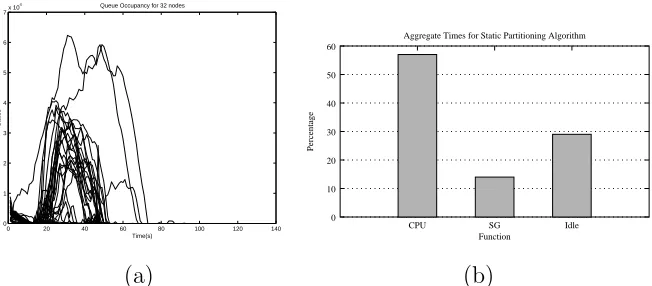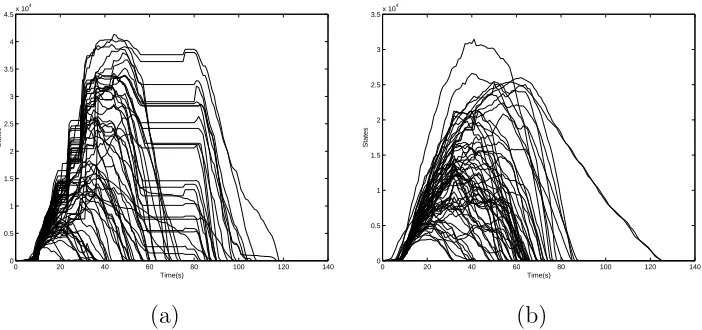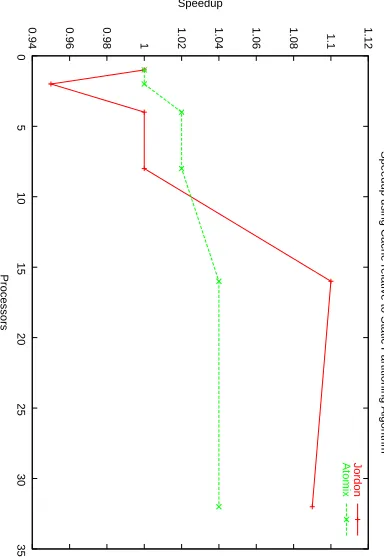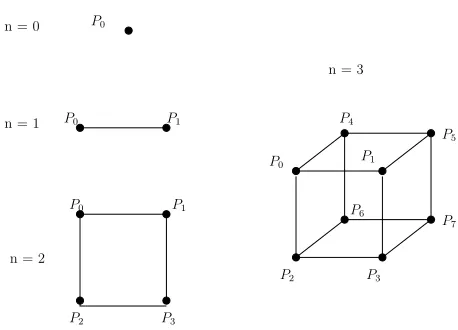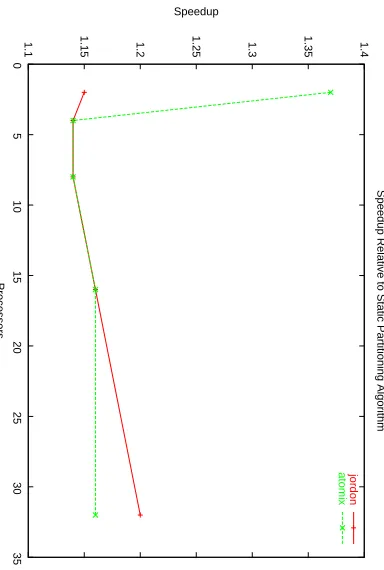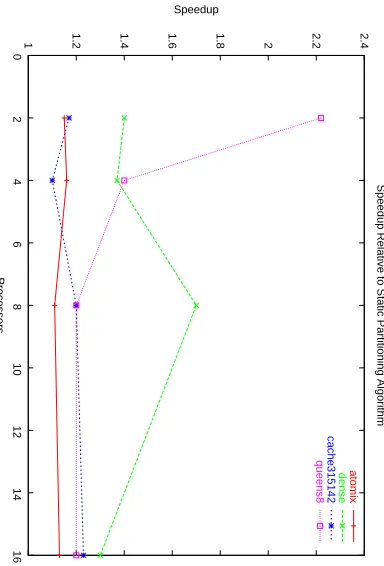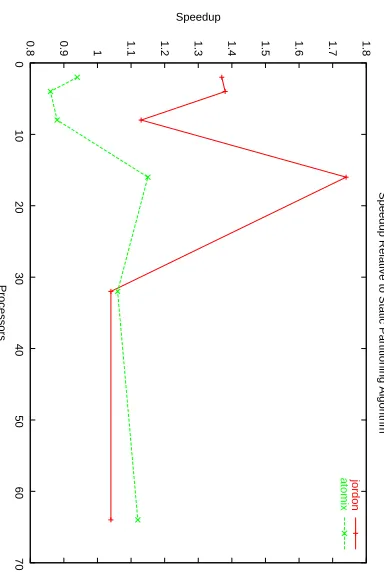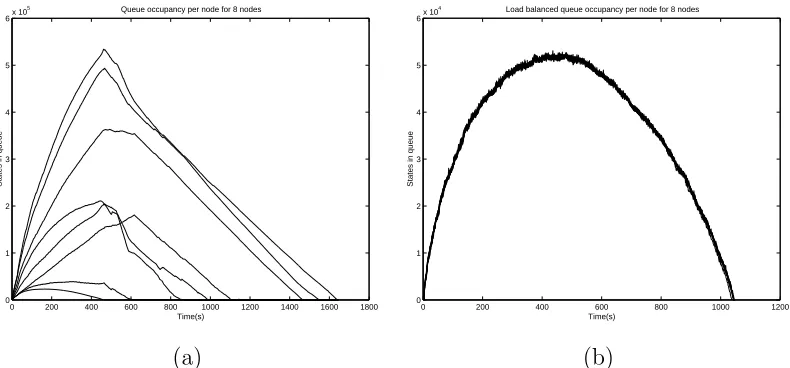Load Balancing Parallel Explicit State Model
Checking
Rahul Kumar
1and Eric G. Mercer
2Verification and Validation Laboratory Department of Computer Science
Brigham Young University Provo, USA
Abstract
This paper first identifies some of the key concerns about the techniques and algo-rithms developed for parallel model checking; specifically, the inherent problem with load balancing and large queue sizes resultant in a static partition algorithm. This paper then presents a load balancing algorithm to improve the run time performance in distributed model checking, reduce maximum queue size, and reduce the number of states expanded before error discovery. The load balancing algorithm is based on generalized dimension exchange (GDE). This paper presents an empirical anal-ysis of the GDE based load balancing algorithm on three different supercomputing architectures—distributed memory clusters, Networks of Workstations (NOW) and shared memory machines. The analysis shows increased speedup, lower maximum queue sizes and fewer total states explored before error discovery on each of the architectures. Finally, this papers presents a study of the communication overhead incurred by using the load balancing algorithm, which although significant, does not offset performance gains.
1
Introduction
Explicit state model checking is a methodology to verify properties in a design through reachability analysis. The practical application of model checking, however, is hindered by the state explosion problem [5]. State explosion is a result of enumerating the state space of a concurrent system using interleaving semantics where each concurrently enabled transition must be considered sep-arately in any given state. Several techniques exist to address aspects of the
1 Email: [email protected]
2 Email: [email protected]
state explosion problem. Symmetry and partial order reduction exploit struc-ture and concurrency to reduce the number of states in the reachable state space that must be explored to complete the model checking problem [3][6]. Bit state hashing (supertrace) and hash compaction reduce the cost of storage states in the reachable state space [7][13]. All of these techniques enable the verification of larger problems, but in the end, are restricted to the number of states that can be stored on a single workstation. If the model checking algorithm exhausts resources on the workstation it is running on before com-pletion of the verification problem, then the problem must be altered in some way to reduce the size of its reachable state space until it can fit into the available resources.
The goal of distributed model checking is to combine the memory and computational resources of several processors to enhance state generation and storing capacity. The seminal work in distributed model checking presented by Stern and Dill creates a static partition of the reachable state space during ex-ecution [14]. The workload observed as a function of time and communication overhead on each processor depends critically on how the states are partitioned between the verification processes. Several techniques such as caching (sibling and state), partial order reduction, symmetry reduction, different partition functions and dynamic partitioning have been explored in the past to reduce communication overhead and create perfect state distributions [11][10]. Even with the use of the above mentioned techniques, creating a perfect partition for any given problem while maintaining equally loaded processors requires a
priori knowledge of the state space, which is the very problem we are trying
to solve.
2
Models and Platforms
Empirical analysis of this work is performed to better understand the per-formance of the static partitioning algorithm and other techniques using par-allel Murϕ [9]. Testing is done and results are gathered on the following platforms:
(i) IBM 1350 Linux Cluster which has 128 dual processor nodes with high speed interconnect;
(ii) Network of workstations (NOW) with 100 Mbps interconnect; and (iii) Marylou10 IBM pSeries 690 64 Power4+ processors @ 1.7 GHz 64 GB
total memory.
A major part of the testing is performed using the models located at the model database in [1]. These models have been selected because they provide a large, controllable, interesting and diverse set for testing. The selected models are not representative of all types of problems, but they effectively capture our general observations in studying the several problems.
3
Analysis of Distributed Model Checking Techniques
This section will first analyze the static partition algorithm and present the problems encountered when using it. After the analysis, we discuss two ex-isting techniques to solve these problems. Our results indicate that these techniques are not very effective on the models and benchmarks used by us.
3.1 Queue Imbalance and Idle Time
The static partition algorithm enables the verification of larger models at a much faster rate using several processors. Our further investigation of the algorithm supports the conclusion that idle times during distributed verifica-tion are high, and there is a high imbalance in the distribuverifica-tion of states across the queues of the participating processors causing premature termination, de-graded error discovery and large queue sizes. Figure 1(a) shows the sizes of the queues as sampled at one second intervals for all processors during the en-tire period of verification using 32 processors on the NOW architecture. The interval sampling is implemented using the alarm and signal utilities avail-able on mostUNIXbased systems. The horizontal axis represents time and the vertical axis represents the number of states in the queue of a given processor. The figure shows the imbalance in queue sizes, with many processors having useful work to do only in the early part of the verification. During the latter part of the verification, only 20% of the processors are active. These results are consistent with recent work by Behrmann, [2] where the same imbalance is observed.
0 20 40 60 80 100 120 140
Queue Occupancy for 32 nodes
0
Aggregate Times for Static Partitioning Algorithm
(a) (b)
Fig. 1. This figure shows the high queue imbalance through time and time distri-bution for the major functions using an IBM 1350 cluster. (a) Queue sizes for the
jordon model using 32 processors. (b) Aggregate times for all processors for major functions in verification showing a large idle time.
on the major composite functions during verification for the atomix model. The major composite functions are CPU, State generation(SG), and Idling. CPU is time spent performing I/O operations and communication. State generation time is defined to be the time spent processing states from the queue and generating their successors. Idle time is the time spent waiting for new states to be received because the processors search queue is empty. In this state, the verification processor is still processing messages. The states in the messages are discarded however, because they have been previously added to the hash table. The figure demonstrates that after communication, idle time dominates. In fact, almost a third of the total aggregate time is spent idling. Similar results have been observed for other models of varying size and shape.
3.2 Partition Function
Idle time is a direct result of load imbalances. This is seen in experiments with various hash functions and their effect on speedup. We have studied the effects of the partition function on the distribution of states by implementing the partition function various hash functions including several hash functions in
SPIN[8]. Figure 2(a) shows the queue distribution for 64 queues on the NOW
architecture using the single bit forward hash function from SPIN. Although more processors remain active through the verification run when compared to Figure 1(a), a significant number still become idle and remain idle for over half the running time of the verification process. Figure 2(b) shows the same queue distribution using a different bit mask for the same hash function taken from
SPIN. The distribution is extremely different even though all other parameters
0 20 40 60 80 100 120 140
Fig. 2. Queue imbalance for the atomix model using 64 processors and two different hash functions from Spin on the NOW architecture.
and to then maintain that distribution through the entire verification process, requires an a priori knowledge of the state space is required. This is the very problem we are trying to solve in the first place.
3.3 State Cache
A technique to improve performance of distributed model checking is the use of state caching to reduce the number of messages and hash lookups. Previous work regarding state caching, to improve performance has been presented in [11][4]. Our analysis indicates the presence of duplicate states in the same message or in different messages being sent to other processors. This is due to the fact that many states in the state space of the model can be reached by different paths and from different states. To avoid this, a block of memory is allocated on each processor to function as a direct mapped state cache. Only states not present in the cache are forwarded to their owning processors.
0.94 0.96 0.98
1
1.02 1.04 1.06 1.08
1.1 1.12
0
5
10
15
20
25
30
35
Speedup
Processors
Speedup using Cache relative to Static Partitioning Algorithm
Jordon
Atomix
Fig. 3. Speedup relative to the static partition algorithm obtained using a cache of size 1 MB on IBM 1350 Cluster.
4
Methods
P0
P1
P3
P2 P3
P7 P5 P4
P1
P6
n = 2
n = 3
n = 1
n = 0 P0
P2
P0 P1
P0
Fig. 4. Hypercube structure for 1 to 8 processors.
scenario of 4 processors P0, P1, P2 and P3. Let us suppose that P1, P2 and P3 are ready for load balancing and have already initiated the load
balanc-ing phase. If in this situation P0 happens to be very heavily loaded inserting
states into its queue, P0 will be unable to enter the load balancing phase at
the same time as the other processors, causing the other processors to wait until P0 has finished processing states/messages and enter the load balancing
phase.
We use Generalized Dimensional Exchange(GDE) for load balancing which performs iterative load balancing among the involved processors by having each processor equalize its workload with each dimensional neighbor [15][16]. Dimensional neighbors are calculated based on the topology selected for the processors. Our GDE methodology groups processors in the verification pro-cess into a hypercube like structure. Figure 4 shows the structure of a hy-percube for 1 through 8 processors as well as the number of dimensions that are created in each case. The GDE algorithm setup is similar to the edge coloring problem where no two edges can be assigned the same color; thus, if processors in a hypercube structure are colored with the same rules as the edge coloring problem, there will be ⌈log(N)⌉colors that are needed, where N is the number of processors. Each color can then be thought of as a dimen-sion with a subset of the processors belonging to a particular dimendimen-sion. This network structure enables us to view the processors in an elegant manner and implement algorithms that are more efficient communication.
In the GDE load balancing scheme, each node balances the workload (num-ber of states in the queue) with its dimensional neighbors. In a network of 8 processors, processor P0 balances with processors P1, P2 and P4. During the
Algorithm: GDEBalanceQueues()
1: /∗ Method called by BFS/DFS every i iterations on each process ∗/
2: for AllDimensionalN eighbors do
3: n:=getN extDimensionalN eighborID()
4: q:=getLocalQueueSize()
5: s:=sendQueueSizes(n, q)
6: return
Fig. 5. GDE load balancing algorithm from sending end.
Algorithm: HandleM essage(M, ID)
1: /∗ If a queue size is received from ID then need to load balance ∗/
2: /∗ Get queue size of neighbor from message M ∗/
3: qn=getQueueSize(M)
4: ql :=getLocalQueueSize()
5: if ql > qn then
6: sendStates((ql−qn)/2, ID)
7: else
8: /∗ Receive happens in a non-blocking fashion ∗/
9: receiveStates((qn−ql)/2, ID)
10: return
Fig. 6. GDE load balancing algorithm on receiving end.
value for creating an equilibrium state in as few iterations as possible is 1
2.
Figures 5 and 6 show the pseudo code for the algorithm. Every i iterations wherei is the balance frequency set by the user, the processor sends its current queue size to it’s dimensional neighbors. On the receiving side, once a proces-sor receives a queue size from a dimensional neighbor, the procesproces-sor executes the algorithm shown in Figure 6. If the workload on the local queue is higher than the workload on the neighbor, then states are sent to the neighbor. If on the other hand the workload is not higher, no action is taken and execution is returned to state generation and communication procedures. Receiving states from other processors happens implicitly and no blocking occurs. For our testing purposes we set the exchange parameter to be one half and the bal-ance frequency to be 1
1000 states. A balance frequency of 1
1000 means that load
balancing is initiated after 1000 states have been processed from a processor’s queue, or if the processor’s queue is empty.
5
Results
1.1 1.15 1.2 1.25 1.3 1.35 1.4
0
5
10
15
20
25
30
35
Speedup
Processors
Speedup Relative to Static Partitioning Algorithm
jordon
atomix
Fig. 7. Speedup for the GDE scheme relative to the static partitioning algorithm on the IBM 1350 Linux Cluster.
1 1.2 1.4 1.6 1.8 2 2.2 2.4
0
2
4
6
8
10
12
14
16
Speedup
Processors
Speedup Relative to Static Partitioning Algorithm
atomix
dense
cache315142
queens8
Fig. 8. Speedup for the GDE scheme relative to the static partitioning algorithm on NOW architecture.
Figure 10(a) shows the state of the queues every second after applying the GDE load balancing algorithm when using 32 processors on the IBM Cluster. Comparing this to Figure 1(a), a significant difference is seen in using the GDE load balancing algorithm. More processors have states to expand throughout the verification. Also, the number of snapshots taken in each case indicates that only half the time was needed to verify the model completely. Figure 10(b) shows the percentage of the time spent on the major modules in the parallel model checker. Compared to Figure 1(b) we can see that due to the load balancing, the idle time is reduced from 35% of the total time to almost nothing and the CPU time has been increased due to extra communication to improve performance.
Figure 11(a) shows the state of the queues before load balancing and Fig-ure 11(b) shows the state of the queues after load balancing on the NOW architecture. For this particular example a higher balancing frequency was used to achieve a better balance. As can be seen from the figure, using a higher frequency created a near perfect distribution of the states among the participating queues. A speedup of 1.6 was achieved in this case.
0.8 0.9
1 1.1 1.2 1.3 1.4 1.5 1.6 1.7 1.8
0
10
20
30
40
50
60
70
Speedup
Processors
Speedup Relative to Static Partitioning Algorithm
jordon
atomix
Fig. 9. Speedup for the GDE scheme relative to the static partitioning algorithm on the shared memory architecture.
0 10 20 30 40 50 60 70 80 90
0 2000 4000 6000 8000 10000 12000
Time(s)
States
Queue Occupancy for balanced queues in 32 nodes
0 10 20 30 40 50 60 70
CPU SG Idle
Percentage
Function Aggregate Times for GDE Load Balanced Algorithm
(a) (b)
0 200 400 600 800 1000 1200 1400 1600 1800
Queue occupancy per node for 8 nodes
0 200 400 600 800 1000 1200
0
Load balanced queue occupancy per node for 8 nodes
(a) (b)
Fig. 11. Balanced and unbalanced queues for the jordon model on the NOW archi-tectures(a) Queue sizes for the jordon model using 8 processors before load balanc-ing. (b) Queue sizes for the jordon model using 8 processors after load balancing showing highly balanced queues.
Table 1
Average number of states generated before error state discovered
Model Static Partition GDE Algorithm Speedup
queens8-deadlock 22546 500 45.09
adash1212 17650 8500 2.08
jordon 6600 3860 1.71
queens8-error 1505086 962343 1.56
arbiter4 4416 3300 1.34
sparse-shallow 31640626 25866803 1.22
atomix 2150688 1983550 1.08
two diamonds 2280376 2156913 1.06
A major challenge with the static partitioning algorithm is the early termi-nation of verification due to lack of space available in the queues of individual processors. In extremely large and dense models with high branching factors, each processed state generates a lot of successors that have to be saved in the queue. If a queue has not been allocated with enough memory to ac-commodate these states, then the verification process has to be discontinued and verification cannot complete. A high number of states in a queue also occurs due to the high load imbalance in the queues of the processors. A pro-active effort is made to keep the queues in a state of equilibrium. The GDE load balancing algorithm, which implicitly causes the queues to be smaller and more manageable; thus, it reduces the strenuous memory requirements of the queue for each processor. Table 2 shows the maximum size of the queue for each algorithm for various models using 8 processors in the verification and the standard deviation within the maximum queue size on each processor for both the static partition and GDE load balanced algorithms. From the table we can see that there is a large difference between the static partition algorithm, and the GDE load balanced algorithm. For the load balanced algo-rithm, the maximum queue size is almost an order of magnitude smaller than the maximum queue size for the static partition algorithm, and the amount of memory used for the queue differs by an equal proportion. The standard deviation for the maximum queue sizes for each algorithm is shown in the last two columns of Table 2. For the static partition algorithm, we can see that the standard deviation is very large compared to the maximum queue size. In contrast, the GDE load balanced scheme provides much lower standard deviations indicating that the queues are in an equilibrium state.
Table 2
Maximum queue size and standard deviation of maximum queue size
Model Max Queue Size Ratio Standard Deviation
Static Partition GDE Static Partition GDE
dense 352226 30824 11.43 139137 575
jordon 511934 54387 9.41 183442 249
two diamonds 389792 48351 8.06 118165 149
sparse-shallow 377491 80416 4.69 117099 855
atomix 239938 62261 3.85 76428 319
queens8 1587876 418589 3.79 235335 2679
cache315142 289803 97492 2.97 99843 579
Table 3
Average number of messages exchanged between two processors
Model Static Partitoin GDE Algorithm Percentage
atomix 276751.41 254148.7 -8.17
dense 324927.66 320916.58 -1.23
cache315142 350984.19 349259.3 -0.49
jordon 621258.95 632280.92 1.74
sparse shallow 993826.05 1032035.14 3.7
queens8 242680.2 254276.52 4.56
two diamonds 994516.56 1112782.97 10.63
than the messages exchanged in the static partition algorithm. This is due to the state cache. For the other cases the number of messages sent in the load balanced version is greater but within the same order of magnitude. The last column displays the difference as the percentage relative to the higher number of messages sent. We can see that the in the worst case, only 10% more messages are sent to achieve a speedup of 1.6 times. This communica-tion overhead is acceptable since it provides us with balanced queues, smaller queues and improves the error detection capabilities of the model checker.
6
Conclusions and Future Work
in terms of speedup over the static partition algorithm.
Using load balancing techniques such as GDE, we have successfully bal-anced the queues on all processors and reduced the time to verify models in our benchmark suite. Due to the non-deterministic nature of the GDE load balancing algorithm, we have also changed the search order to the degree where error states in our models can be discovered earlier and by exploring a fewer number of states. Using the GDE load balancing algorithm we have also shown that maximum queue sizes have been decreased by an order of magnitude compared to the maximum queue sizes obtained in the static par-tition algorithm for the models and benchmark suite used by us. We have also shown that the communication overhead does not counteract the usefulness of GDE load balancing when using a state cache.
Future work in this research area would involve creating load balancing schemes that are completely independent of any user input regarding the fre-quency of load balancing. Processors should be capable of avoiding situations where there is no useful work to do. A more detailed study of the GDE scheme with respect to the amount of load balancing done between a pair of proces-sors is also important. Other dynamic load balancing schemes also provide an interesting field of further research too.
References
[1] VV Lab Model Database. http://vv.cs.byu.edu.
[2] G. Behrmann. A performance study of distributed timed automata reachability analysis. In Electronic Notes in Theoretical Computer Science, volume 68. Elsevier, 2002.
[3] E. M. Clarke, T. Filkorn, and S. Jha. Exploiting symmetry in temporal logic model checking. In Proceedings of the 5th International Conference on Computer Aided Verification, pages 450–462. Springer-Verlag, 1993.
[4] C. Demartini, R. Iosif, and R. Sisto. dSPIN: A dynamic extension of SPIN. In
SPIN, pages 261–276, 1999.
[5] O. Grumberg E. M. Clarke Jr. and D. A. Peled. Model checking. pages 9–11, 2002.
[6] P. Godefroid and P. Wolper. Using partial orders for the efficient verification of deadlock freedom and safety properties. InProceedings of the 3rd International Workshop on Computer Aided Verification, pages 332–342. Springer-Verlag, 1992.
[8] G. J. Holzmann. The model checker spin. IEEE Trans. Softw. Eng., 23(5):279– 295, 1997.
[9] M. Jones, E. Mercer, T. Bao, R. Kumar, and P. Lamborn. Benchmarking explicit state parallel model checkers. In Electronic Notes in Theoretical Computer Science, volume 89. Elsevier, 2003.
[10] R. Kumar, M. Jones, J. Lesuer, and E. Mercer. Exploring dynamic partitioning schemes in hopper. Technical Report 3, Verification and Validation Laboratory, Computer Science Department, Brigham Young University, Provo, Utah, September 2003.
[11] F. Lerda and W. Visser. Addressing dynamic issues of program model checking.
Lecture Notes in Computer Science, 2057:80–100, 2001.
[12] D. M. Nicol and G. Ciardo. Automated parallelization of discrete state-space generation. Journal of Parallel and Distributed Computing, 47(2):153–167, 1997.
[13] U. Stern and D. L. Dill. Improved Probabilistic Verification by Hash Compaction. In Correct Hardware Design and Verification Methods, volume 987, pages 206–224, Stanford University, USA, 1995. Springer-Verlag.
[14] U. Stern and D. L. Dill. Parallelizing the Murphi verifier. pages 256–278, 1997.
[15] M. H. Willebeek-LeMair and A. P. Reeves. Strategies for dynamic load balancing on highly parallel computers. IEEE Trans. Parallel Distrib. Syst., 4(9):979–993, 1993.
